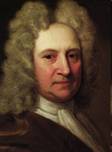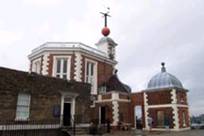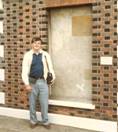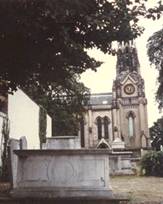A HALLEY ODYSSEY
PART I
London – Greenwich – Lee
By Joseph M. Laufer
This is the first in a three-part series on a unique Halley Pilgrimage made by Editor Joseph M. Laufer. The trip, made in September, 1984, took him to London, Greenwich and Lee, England to see first-hand the major “shrines” of Edmond Halley. From London he journeyed to Padua, Italy, to visit the famous “Adoration of the Magi” fresco painted by Giotto, commemorating the 1301 return of Halley’s Comet. The final stop on the Halley journey was the town of Bayeux, France, to view the famous tapestry which represents the 1066 return of Comet Halley on this pictorial record of the Battle of Hastings. This first installment deals with the visit to the historic locations in England.
The opportunity to travel to Europe for the first time in my life came about through the converging of three lifetime ambitions. One was to trace my family roots in a small town in the Black Forest region of West Germany. Another was the desire to visit certain historic and religious shrines in Europe, paramount among them, Assisi, Italy, the city of St. Francis, and Rome, the Eternal City. There was also a certain compulsion to visit the Normandy landing beaches during the 40th anniversary year of D-Day. The third ambition was to make my role as a self-proclaimed Halley expert more credible and authentic by somehow personally connecting with those tangible memorials to past visits of Halley’s Comet and to get as close to the man himself and the places where he made his immortal contributions to Astronomy and society itself.
The occasion for the visit was a sabbatical generously awarded by Burlington County College, where I have been employed since 1970. What was originally planned as a brief visit to Germany to gather genealogical information became a multi-faceted trip thanks to the invitation of Brian V. C. Harpur, founder of the Halley’s Comet Society, to participate in the 9th annual gala of his Society scheduled for September 11, 1984 aboard the Sir Walter Raleigh, anchored in the middle of the Thames in the shadow of the Tower of London.

Edmond Halley
On the morning of September 10 I took a train from London to Greenwich. It was here at the Royal Observatory that Edmond Halley made the observations needed for accurately determining the moon’s orbit. Much of his work was carried out in a small brick building where instruments were set up in two rooms now called Flamsteed’s Quadrant House. Edmond Halley succeeded John Flamsteed, the first Astronomer Royal. In 1719, at the age of 62, Halley was named second Astronomer Royal. As Royal Astronomer, Halley lived in the still-standing Flamsteed House. Within this house is the famous Octagon Room in which telescopes were used from 1676 to 1830. The visitor cannot help but picture Edmond Halley in this very room looking through a primitive telescope at the moon and at the stars and possibly a comet. It is possible that John Flamsteed would have permitted him to view the comet of 1682 from a telescope in this room. We know for a fact that Halley saw his comet from his own observatory in Islington, a borough of Greater London, on November 22, 1682 at the age of 25. Flamsteed viewed the comet from Greenwich on August 15, 1682. The room now serves as a museum, containing many relics of the Flamsteed-Halley period.

Greenwich Observatory. Flamsteed House to the right (with dome)
Halley Memorial slab in view. Just to the right, off photo, is the prime meridian.
Just outside the entrance to Flamstted House is a small domed edifice that looks like an over-sized sentry station. In the space that was apparently originally occupied by a window, a marble slab has been inserted. This 240-year-old slab has apparently had to be repaired several times with little attempt to match the original material. This is the monument to Edmond Halley at Greenwich. It is the original top slab of his tombstone. It bears this inscription in Latin: “Under this marble peacefully rests, with his beloved wife, Edmond Halley, LL.D. unquestionably the greatest astronomer of his age. But to conceive an adequate knowledge of the excellencies of this great man, the reader must have recourse to his writings; in which almost all the sciences are in the most beautiful and perspicacious manner illustrated and improved. As when living he was so highly esteemed by his countrymen, gratitude requires that his memory should be respected by posterity.”

Joe Laufer in Greenwich at the Halley Memorial,
the original slab from the top of his tomb
Unfortunately, during my visit, I observed that very few tourists stopped at the monument to read the small placard that explains the memorial. The placard indicates that this is the original tombstone which was replaced by a newer one in 1854 and that Edmond Halley lies buried at Lee, a town only about four miles from Greenwich. It was my intention to make th trip to Lee, but since I was to meet with Brian Harpur that evening, I would have to postpone that visit until the following day.
As I toured the Old Royal Observatory at Greenwich, I was impressed by several tributes to Edmond Halley. Very little is made of his contributions to Cometry, but much is made of his overall scientific genius. He is hailed as the Second Royal Astronomer, an honor which he held for almost 23 years, until his death in 1742 at the age of 85. In Flamsteed House there is a “Halley Gallery”, an area that was added in 1835 as three additional living rooms for Professor Airy, the Seventh Astronomer Royal. This area currently holds examples of models of the heavens of various sorts, including one of the most important astrolabe collections in the world.
My visit to Greenwich, then, was not just a visit to the Prime Meridian of the world on its centenary in 1984, but it was the first stop at a major monument to the genius of Edmond Halley a year before his comet was to return on its fourth visit since he made the momentous prediction in n1705. The little placard next to Halley’s tombstone had helped me decide on my next stop on the pilgrimage. It would be Lee and Halley’s actual burial place.
An evening dinner meeting with Brian Harpur and his wife Mimi and their friends at a plush London Casino/Restaurant served as the occasion for obtaining specific directions to Halley’s tomb in Lee. Mr. Harpur sketched a map on the back of a letter I had with me. It reminded me of a pirate’s search map for a hidden treasure. Brian warned me that it was difficult to find the tomb and without his directions, my excursion would not yield its treasure. How right he was. Not only would it be difficult to find the tombstone; just finding the graveyard would become a major undertaking.
On the morning of September 11 I boarded a commuter train to Lee. It was an overcast day and I thought for sure that I’d need an umbrella before the day was over. The twenty-five minute train ride was interrupted by my inability to trust my railroad map. I got off the train one stop too soon and had to wait for the next train to Lee. When I finally arrived at Lee, I asked the local train-station attendant where the tomb of Edmond Halley was located. He had no idea. In fact, he wanted to know who Edmond Halley was, and was he the bandleader? (Bill Haley and the Comets?) After I explained about Halley’s Comet, he seemed to understand, but was not able to give me directions. Well, did he know where St. Margaret’s Church was? No, but perhaps someone sitting in the waiting room would (it was a small station, and there were only three or four women in the waiting room). None of them could be sure where St. Margaret’s Church was.
I decided to venture into the city, where I was sure someone could direct me to St. Margaret’s. A right turn on foot out of the station onto a major road (which was being re-paved on the day I was there), led me into the town of Lee. I have not been able to determine the population, but I assume that it was a town of about 40,000. As a tourist, I felt that I was a rarity in town. Lee was not your basic tourist attraction. I was glad I was there, however, since it gave me an idea of what a London suburb was really like. As I approached what appeared to be the beginning of the main business section of town, I stopped at a News Stand (similar to a U.S. News, tobacco and candy store). The proprietors were cordial to this obvious tourist (equipped with camera and map), but they did not know of a St. Margaret’s Church. They checked the telephone directory and a small city map, but to no avail. A customer was asked, but all they could come up with was that there was a church with an old cemetery at the top of the hill. They weren’t sure that Edmond Halley was buried there, but it seemed to fit my description of an old churchyard.
Further on down the road at the major town intersection I discovered the local police station. A young Bobby showed me on a map where St. Margaret’s was located. Confident that I understood his directions, I continued down the street. For security reasons, I stopped at a “Fun Shop” to verify whether I was to make a left or right turn off this street. The proprietors weren’t certain that it was St. Margaret’s, but there was a church with an old cemetery at the top of the hill on the right. Onward and upward I went. A steeple came into view and I somehow knew that it had to be St. Margaret’s. I was on Lee Terrace with the town of Blackheath and the Greenwich Royal Observatory behind me. I passed St. Joseph’s Prep School. A short distance down the road was what I hoped was St. Margaret’s Church – and old rusty-brown building with a high clock-tower steeple. The clock was stopped at 12:05. It was, in fact, 10:15 a.m.
Brian’s map was called into action. Just as he had laid it out, there was the new cemetery adjacent to the church, and across the street, beyond the bus stop, was the old ruin of a church (a beautiful picture in itself) and an old cemetery. According to Brian’s map, Halley’s tomb would be to the right of the old church ruins. It took two or three walk-throughs to finally come upon the tomb. The discovery brought a chill to my body. Friends might think I’m foolish, but it was as though I had discovered the Holy Grail. Here I was, an American from Vincentown, New Jersey, standing before the tomb of Edmond Halley in the town of Lee, England. After the trek through Lee (the cemetery was about four-and-a-half miles on foot from the train station) and the unawareness of the local inhabitants of the monument in their midst, I felt very special. Was I the first American to make this kind of a trip? Had many other Enlishmen (besides Brian Harpur, of course) bothered to make this pilgrimage?
Brian Harpur had prepared me for the scene: an unattended cemetery, a deteriorating tomb. It was, in fact, worse than I had expected. There was litter and debris at the entrance to the cemetery and the top of Halley’s tomb (restored, as it was, in 1854 by the Lords of the Admiralty), was covered with mold and mildew. In order to read the inscription, you had to scrape off the residue. I wondered if anyone would make an effort to spruce things up in anticipation of the return of Halley’s Comet next year. I understood why Brian Harpur and his Halley’s Comet Society wanted to have a plaque installed in Westminster Abbey to honor Halley).
(Editor’s note in 2004: As a result of this article and my description of the poor conditions laid out in the above paragraph, Brian Harpur raised funds to have the top of the tomb restored. When I returned in 1986 I was pleased to see a beautifully restored tomb, with the lettering gilded for easy reading. This American tourist felt good about having made a difference!)

Joe at the restored tomb of Edmond Halley
a year after this article appeared in print
I took a number of photos of the tomb and its environment. I went across the street to photograph “new” St. Margaret’s. I went back to the old cemetery several times. I tarried, feeling that having come all this way, I should do something at this hallowed site.
The tomb is one of the largest in the cemetery, measuring about six feet in length, three feet in width and four feet in height. In addition to the Latin inscription on the top slab (a reproduction of the original slab now on display at Greenwich), there is an inscription on the front which reads: “Restored by the Lords Commissioners of the Admiralty, 1854”. On the back section is the inscription: “John Pond, born 1767 was elected Astronomer Royal 1811 which office he resigned 1835 and died 1836”. I have not been able to learn why this is on Halley’s tomb, unless it was a means for the Lords of the Admiralty to also memorialize Pond, the Sixth Astronomer Royal.
Below the tribute to Halley, which is inscribed on the top slab, it is noted that in addition to Halley and his wife, three other people are buried here: M. Margaret Halley, their eldest daughter who died on October 15, 1713 at the age of 55 and Mrs. Catherine Price, their youngest daughter, who died on November 10, 1765 at the age of 77 and her husband, Mr. Henry Price.

Halley's Tomb in foreground;
St. Margaret's Church in background
While I was there reading the inscriptions and snapping photographs, several of the boys from St. Joseph’s Prep school walked by, wondering what I was doing. As the bus stop was just outside the gate of the old cemetery, several men and women looked on curiously as I continued gathering the information I had traveled so far to obtain.
The time came to leave, as I had other sites to visit and a Halley’s Comet Society gala to prepare for that evening. I jotted down information from the sign in front of St. Margaret’s. The Reverend Dick Butler was listed as the Rector and the address of the Rectory was given. I would eventually write the Reverend Mr. Butler to tell him of my pilgrimage.
I returned to the main section of Lee via Brandram Road, the street which St. Margaret’s faces. On the way back, I stopped at the News Stand to tell the proprietors of my success, then on to the train station where the station-master asked me why I would take such a trip. I tried to explain, but I know the message didn’t come through. The train arrived and I boarded it with London as my destination. As I rode back I had a feeling of great accomplishment. I had done what I had set out to do. I had my encounter with Edmond Halley – personally. In just a little over a year I would encounter his comet. It would be all the more meaningful.
As I approached London I wondered whether I would get a similar feeling in a few days when I would visit Padua and Giotto’s comet and then Bayeux and Harold’s (or William’s) comet.
NEXT ISSUE: Padua and Giotto’s “Adoration of the Magi”.
Halley’s Comet Watch Newsletter. Volume 3, Number 4 – December, 1984
|